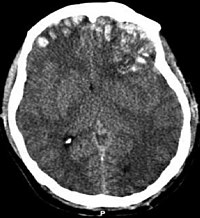
Photo from wikipedia
STUDY OBJECTIVE Existing clinical decision rules guide management for head-injured children presenting 24 hours or sooner after injury, even though some may present greater than 24 hours afterward. We seek… Click to show full abstract
STUDY OBJECTIVE Existing clinical decision rules guide management for head-injured children presenting 24 hours or sooner after injury, even though some may present greater than 24 hours afterward. We seek to determine the prevalence of traumatic brain injuries for patients presenting to emergency departments greater than 24 hours after injury and identify symptoms and signs to guide management. METHODS This was a planned secondary analysis of the Australasian Paediatric Head Injury Rule Study, concentrating on first presentations greater than 24 hours after injury, with Glasgow Coma Scale scores 14 and 15. We sought associations with predictors of traumatic brain injury on computed tomography (CT) and clinically important traumatic brain injury. RESULTS Of 19,765 eligible children, 981 (5.0%) presented greater than 24 hours after injury, and 465 injuries (48.5%) resulted from falls less than 1 m and 37 (3.8%) involved traffic incidents. Features associated significantly with presenting greater than 24 hours after injury in comparison with presenting within 24 hours were nonfrontal scalp hematoma (20.8% versus 18.1%), headache (31.6% versus 19.9%), vomiting (30.0% versus 16.3%), and assault with nonaccidental injury concerns (1.4% versus 0.4%). Traumatic brain injury on CT occurred in 37 patients (3.8%), including suspicion of depressed skull fracture (8 [0.8%]) and intracranial hemorrhage (31 [3.8%]). Clinically important traumatic brain injury occurred in 8 patients (0.8%), with 2 (0.2%) requiring neurosurgery, with no deaths. Suspicion of depressed skull fracture was associated with traumatic brain injury on CT consistently, with the only other significant factor being nonfrontal scalp hematoma (odds ratio 19.0; 95% confidence interval 8.2 to 43.9). Clinically important traumatic brain injury was also associated with nonfrontal scalp hematoma (odds ratio 11.7; 95% confidence interval 2.4 to 58.6) and suspicion of depressed fracture (odds ratio 19.7; 95% confidence interval 2.1 to 182.1). CONCLUSION Delayed presentation after head injury, although infrequent, is significantly associated with traumatic brain injury. Evaluation of delayed presentations must consider identified factors associated with this increased risk.
Journal Title: Annals of emergency medicine
Year Published: 2019
Link to full text (if available)
Share on Social Media: Sign Up to like & get
recommendations!